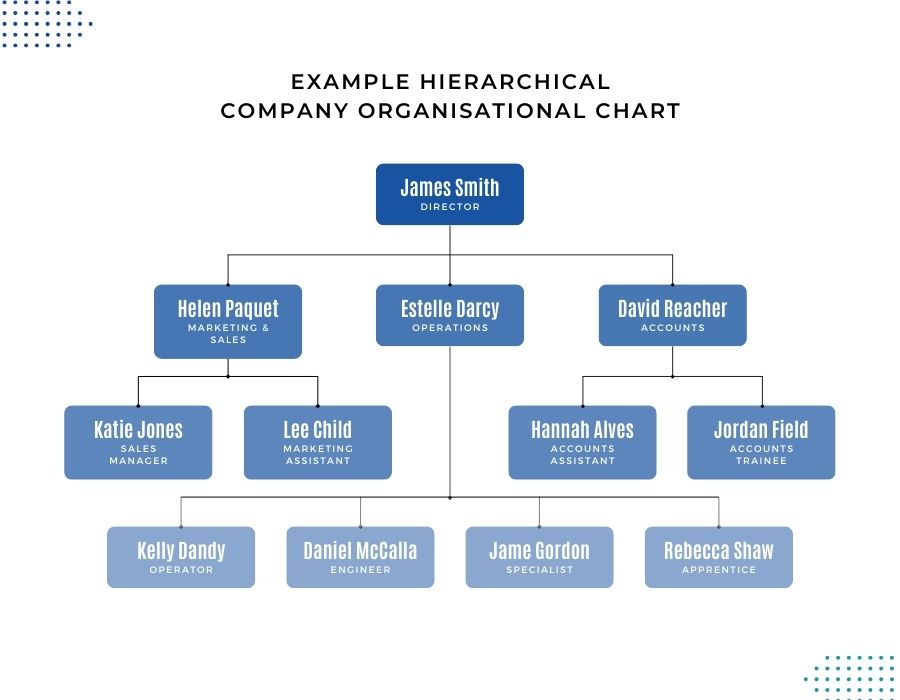As a small business owner, growth and profitability hinge on the effectiveness of your management practices. Regardless of how many staff you have, the management of your time, finances and resources all play a pivotal role in shaping the trajectory of your business.
Taking the time to establish a defined organisational structure is the foundation of your management success. Clearly outlining roles, responsibilities, accountability, and defining hierarchy (no matter how loosely) will give everyone in the organisation clarity, purpose and, most importantly, direction.
Why establishing an organisational structure is essential
Many small business owners and managers struggle with delegation. However, your business can’t grow if you do not relinquish specific tasks in favour of new responsibilities.
Establishing a company hierarchy doesn’t mean you’re creating an old-fashioned, authoritarian or tyrannical enterprise; in fact, it is quite the opposite. An organisational structure will:
- Help staff identify leaders within the business.
- Define those responsible and accountable for tasks within the business.
- Create transparent progression pathways.
- Identify gaps within the organisation.
Identify leaders within the business
A clear organisational structure enables employees to identify leaders and decision-makers within the business. It also gives staff a clearly defined place to go for help and advice on business issues.
As your business grows, an organisational structure will help new staff
understand any change in dynamics and dispel any blurred lines in management.
By knowing who to turn to for workload distribution, guidance and support, employees feel empowered to seek assistance and collaborate effectively.
Defining responsibilities and accountability
Assigning roles and responsibilities will clarify expectations and ensure accountability for tasks and outcomes.
In defining responsibilities and accountability, employees understand their contributions to achieving the organisation’s goals, allowing them to take ownership of their work, leading to increased efficiency and effectiveness.
Responsibility
Responsibility is having a job or a task to do. For Example, if you’re responsible for feeding a dog, it means it’s your job to make sure the dog gets fed.
Accountability
Accountability is about taking ownership of what happens. So, if the dog isn’t fed and it gets sick; you’re accountable and may need to explain what happened to the vet. It’s being responsible for the consequences of the responsibilities, whether they’re good or bad.
An individual may be both responsible and accountable; however, it’s still always best to ensure this is defined and everyone understands their role.
Pathways for progression
An organisational structure provides visibility into career advancement opportunities and progression pathways within the company.
By outlining clear paths for professional development and growth, employees can feel more motivated to invest in their skills and contribute to the organisation’s success, reducing staff turnover and fostering talent retention.
Planning for the future and identifying gaps within the organisation
Creating an organisational structure with established roles and responsibilities can help highlight areas of overlap, inefficiency, or deficiency within the company.
Overlap of roles and responsibilities is to be expected in small businesses as business owners often wear many hats. However, by identifying every position within the organisation, you may find opportunities to engineer changes within the company to outsource or create a new position in which to delegate tasks.
How to create an organisational structure
Here are some simple steps that business owners can take to establish an organisational structure:
1. Start with roles and responsibilities
Create a list of all the roles within the business (actual and ideal) and assign a name next to each. For Example, you may need the following positions within your company:
- Accountant
- HR
- Head of Sales
- Director of Marketing
- Cleaner
- Receptionist
- IT Manager
One person may be next to several of these roles. However, this is the reason we start with roles, not names, as it can help highlight areas of overlap or unstable dependency within the business (if one critical person were to fall ill, is the business too vulnerable).
2. Create an organisational chart
This is a visual representation of the reporting structure of the company. There are many variations of this, some modern and equal, some more traditional and hierarchical. We recommend you do some research and see which model works for you – HubSpot has some further information. However, if you need a starting point, everyone is familiar with the hierarchical chart.
The hierarchical organisational chart depicts the chain of command from top management down to frontline employees. It typically consists of vertical levels, with each level representing a different echelon of authority within the organisation.

3. Create an organisational chart for the future
Once you have created an organisational chart for how the organisation works now, identify how it might look. This future model can be particularly motivating to the staff of small and growing organisations as it shows how they can either develop or recruit support in the future.
4. Regularly review and Update Structure
Ideally, you should review and evaluate your structure to ensure it remains aligned with the company’s goals and objectives. Don’t be afraid to adjust to accommodate changes in the business environment or business needs.
How ETC can help
If you need help creating an organisational chart, dispersing roles and responsibilities or streamlining your business management to increase your profits, please get in touch.
If you are new to ETC, why not contact us for a free new business review? We’ll spend two hours with you, giving you professional coaching and will leave you with actions for immediate implementation.





